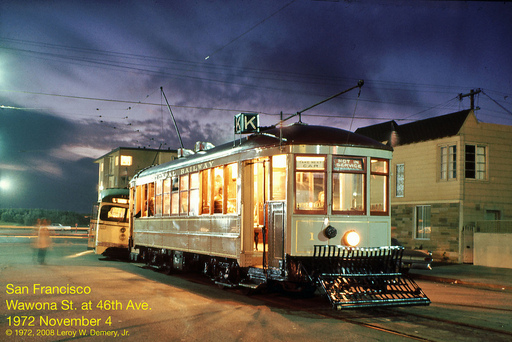Our friends at Streetsblog San Francisco unearthed a wonderful photo by an old friend of MSR, Leroy Demery, Jr. It was taken in 1972 at the L-Taraval terminal at 46th and Wawona, and features Muni’s streetcar No. 1 at the height of its restored glory.

No. 1 had been restored to its original 1912 appearance for Muni’s 50th anniversary in 1962. This included painting the streetcar back into its original gray and red livery with gold striping and lettering (it wore Muni’s green and cream “Wings” livery when originally retired from service in 1951.) It also involved removing the sash in the end section side windows (all Muni’s early streetcars were delivered this way, but these end-section openings were glazed within a few years after passengers rebelled against the cold and drafts).
What’s most striking about this picture, though, is the pristine condition of No. 1, ten full years after its restoration. Plain and simple, that’s because the streetcar was stored under cover (the old Geneva streetcar sheds) when not in use. But within another decade of this shot, the decrepit Geneva sheds were razed and Muni’s streetcars were stored outdoors. It’s obvious the difference covered storage makes.
That’s why Market Street Railway has fought for the last ten years to restore covered storage in Geneva, a project now funded and contracted, with long-delayed construction set to start within a few months. Way too late for No. 1, which, after deteriorating shockingly in the past decade, is now at Brookville Equipment Company in Pennsylvania going through an expensive restoration (all that lead-based paint you see here has now been removed from the car).
At least it will have covered storage when it gets back home. It’s your memberships and donations to MSR that let us carry on the advocacy that is bearing fruit.
Finally! Covered storage after a 25-year wait. Geneva Car House was no prize-winner; I used to think that another big earthquake would take out the last streetcar fleet west of El Paso. Or a stray cigarette butt would land in a pile of old transfers and it would be a fiery end to electric railway service. We dodged catastrophe only to see the cars fall victim to slow disentegration. At OERM we learned the hard way what other museums have learned: Covering the cars is critical.
Historic note: Geneva Car House was still standing on the last night of PCC-only service in Sept. 82; I’m guessing it finally came down around 1984.
Also, does the Geneva office/substation building figure in the covered storage project?
Well, yeah. Every time I see the comparison between cars that stay inside (228, 578S) and cars that stay outside, I see red. The fact that every single one of the outside cars has significant damage (rust/rot) and most have been taken out of service due to water damage (Car 1 – wiring burned out, Car 130 electrical fire, Car 737 various and sundry electrical damage (currently out of service due to water damaged door controls/mechanisms), Car 952 – electrical wiring damage, waterfalls, Car 496 – interior rain…no passenger service on rainy days).
I wonder how many times over a shed could have been paid for with the excess bodywork/maintenance work that has been done over the years.
I notice that 1061 (one of the worst rust monsters) is in the paint shop after a long absence from the line…I wonder how long before all the work has to be redone, again.
Beautiful photo, as stated. I agree with the comments above. The historic cars should have been under cover a long time ago. I’m glad to see that it will finally get done. Question: What about the Metro East Yard? Any covered storage there that could be used by the historic fleet? Hope so.
A year or so ago…water got into the roof signbox and there was some excitement at the switchbox. No structural damage.
OUTSATNDING Image! Thank you for sharing this with the rest of the streetcar fan community.